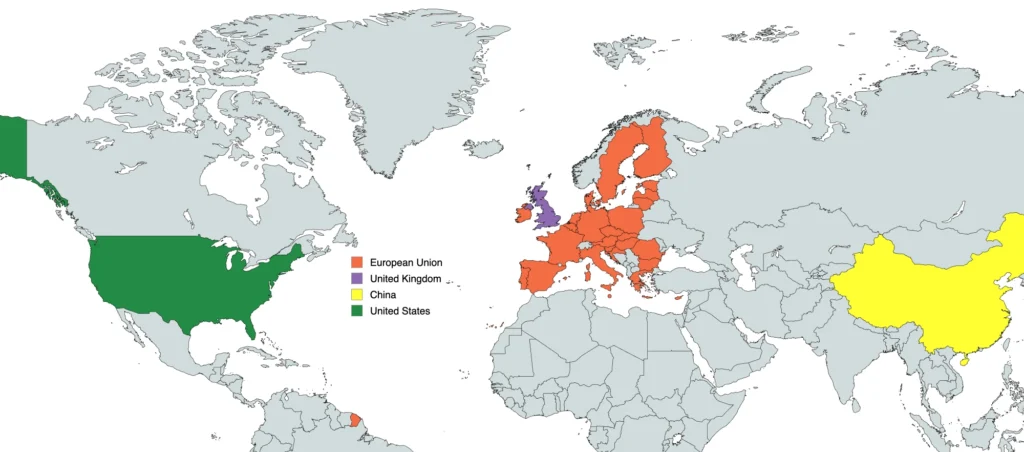General Overview
China has established one of the world’s most comprehensive regulatory environments for artificial intelligence, combining binding regulations with guiding principles that attempt to balance the needs of innovation with social priorities.
I’m fascinated by the tension and need for innovation between a society that prioritizes a particular norm – one that enforces a certain derivative of normalcy that tries to be as predictable and sedate as possible. It’s one of the ways you can successfully run a billion+ person country. Of course, the polar opposite are our Desi friends over in the noisy, riotous, jaywalking-as-a-national-pastime India. Which is the other way to successfully run a billion+ person country.
Also, just remember, I’m not a lawyer, nor am I even cosplaying as a lawyer. This is my way of getting you the information you need so that you can be at least near the starting line when you talk to your lawyer.
The point I want to make here is that the people of China have built a society based on a significant amount of central control. I want to be very clear that I’m not trying to make any sort of societal judgy point. I might have things to say (heh. “might”) about choices pertaining to AI, but when it comes to governing a counts and building a society, I’m going to leave that to the experts. Wherever they are.
AI is non-deterministic. There are things you can do to make it more deterministic, but at its core, the fascinating bits come with an element of chance. It might lie, it might make something up, it might bring up a forbidden topic.
I bet you can do the math here.
So, what you are going to see down below is a well-thought-out attempt at mitigating the risk and danger posed by an important, pervasive technology that introduces an element of chance – and has to do so in order to function!
This overview examines China’s multi-layered approach to AI governance, focusing on key compliance requirements that impact mid-market enterprises developing or deploying AI systems.
We detail (for a pretty high-level value of “detail”) the central components of China’s regulatory framework, including the Interim Measures for Generative AI, algorithm filing requirements, technical standards, comprehensive auditing procedures, and vertical-specific impacts. We’ve included detailed implementation requirements, practical compliance considerations, and forward-looking regulatory developments expected through 2025 and beyond. Each section provides specific source documentation to support deeper exploration of compliance obligations.
For enterprises navigating this complex regulatory landscape, understanding both the technical requirements and their practical business implications is essential for successful AI deployment in the Chinese market.
What Do I Need to Know Right Now?
For decision-makers with limited time, these are the essential compliance requirements for AI systems in China:
Mandatory Algorithm Filing – All significant AI algorithms must be registered with the CAC 30 days before deployment, including details about functionality, logic, and self-assessment reports. Non-compliance can result in service suspension. Source
Content Control Systems – AI systems must implement robust content moderation mechanisms to prevent prohibited content generation, with both automated filtering and human review teams. Service providers are legally responsible for AI-generated content violations. Source
Data Localization – Critical data and personal information must be stored on servers physically located within China, with strict cross-border transfer restrictions. This requirement has significant infrastructure implications for international operations. Source
Regular Auditing – Companies processing data of over 10 million individuals must conduct comprehensive compliance audits at least every two years, with more frequent reviews after significant system changes or incidents. Mandatory data management audits begin in 2025. Source
Human Oversight – All generative AI services must maintain human review mechanisms with the capability for immediate intervention, activity logs, and 24/7 monitoring teams for content control. Source
Content Watermarking – AI-generated content must be clearly identifiable through appropriate marking mechanisms that persist after content modification, following the “Cybersecurity Technology—Methods for Labeling AI-Generated and Synthetic Content” standard. Source
Enforcement Reality – Recent enforcement actions show authorities are actively monitoring compliance, with penalties ranging from warnings to substantial fines ($1.2 billion in Didi’s case) and service suspensions for violations. Source
Timeline
| Date | Event |
|---|---|
| January 10, 2023 | Deep Synthesis Provisions (regulating deepfakes) came into force |
| July 13, 2023 | Draft Measures for the Management of Generative Artificial Intelligence Services released for public comment |
| August 15, 2023 | Interim Measures for the Management of Generative Artificial Intelligence Services became effective |
| November 1, 2023 | Mandatory filing of generative AI services with the Cyberspace Administration of China (CAC) began |
| December 2023 | Start of compliance audits for generative AI services |
| February 29, 2024 | Release of Basic Security Requirements for Generative Artificial Intelligence Services (TC260-003) by the National Information Security Standardization Technical Committee |
| May 23, 2024 | New draft regulations titled "Cybersecurity Technology – Basic Security Requirements for Generative Artificial Intelligence Service" released for public comment |
| January 1, 2025 | Network Data Security Management Regulations take effect, significantly increasing enterprise compliance obligations for AI systems handling data |
| May 1, 2025 | Administrative Measures for Personal Information Protection Compliance Audits become effective, mandating regular audits for AI systems processing personal information |
| Q3 2025 | Anticipated implementation of mandatory data management audits requiring organizations to maintain detailed records of all data transactions for at least 10 years |
| 2025-2026 | Expected release of China's first comprehensive Artificial Intelligence Law (currently in draft stage being circulated among legal scholars) |
Compliance Requirements for Medium Sized Enterprises
| Key Requirement | Implementation Requirements | Business Impact |
|---|---|---|
| CONTENT MODERATION (Systems to filter and review AI-generated content that could "endanger national security," "undermines social stability," or "subverts state power") Required before service launch with ongoing updates |
|
|
| HUMAN OVERSIGHT (Human monitoring and intervention capabilities for AI systems to ensure compliance and responsible operation) Required for all generative AI services before launch |
|
|
| SECURITY ASSESSMENT (Comprehensive evaluation of AI models, data sources, and operational security before deployment) Before service launch and periodically thereafter |
|
|
| DATA LOCALIZATION (Storage of all relevant data on servers physically located within China's borders) Immediate requirement with ongoing compliance |
|
|
| USER VERIFICATION (Real-name verification systems for consumer-facing AI services to ensure accountability) Required for consumer-facing AI services |
|
|
| CONTENT WATERMARKING (Methods to clearly identify AI-generated content through visible or invisible markers) Required with implementation details in technical standards |
|
|
Comprehensive AI Auditing
| Audit Component | Technical Requirements |
|---|---|
| Audit Targets and Frequency |
|
| Audit Methodologies |
|
| Documentation Requirements |
|
| Technical Compliance Standards |
|
Regular auditing forms a cornerstone of China’s AI compliance approach, with increasingly rigorous requirements being implemented through 2025. The following table provides detailed insights into the technical audit requirements, methodologies, and documentation standards that companies must follow.
So – I know, *know* that you’re looking at this thinking “millions of users? I should be so lucky, this is obviously nothing I need to worry about.”
Don’t do that. Yes, you almost certainly will fly under the radar for a while. Maybe long enough for you to hand off the reins or cash out in a nice acquisition (congratulations!).
But, if you aren’t as stealthy as you think. if they figure out that you are flaunting one of their rules… Hoooo baby, I hope that China wasn’t a major part of your revenue because they can shut you right down. And could charge you a hefty fine to start back up.
Good, bad, or indifferent – I have a lot of respect for how they are doing business. They are very clear about their criteria and the lines and say “don’t cross here.” And they have allocated significant resources to making sure that they don’t.
China Regulations Interaction by Vertical
China will be more up in your business than any other geopolitical entity, regardless of vertical. But they certainly care about some verticals more than others.
| Vertical | Impact Level | Key Considerations |
|---|---|---|
| Technology & Software Development | Very High |
|
| Digital Media & Content Creation | Very High |
|
| Finance | High |
|
| Healthcare | High |
|
| E-commerce & Retail | High |
|
| Education | Moderate to High |
|
| Manufacturing | Moderate |
|
| Human Resources | Moderate |
|
Comparisons with Other Geopolitical Entity
Comparison with EU AI Act
| Aspect | China's Approach | EU AI Act |
|---|---|---|
| Regulatory Philosophy | Vertical, sector-specific regulations with strong government oversight | Horizontal framework with risk-based categorization |
| Content Control | Strict prohibitions and content moderation requirements | Focus on transparency and avoiding harm |
| Data Governance | Stringent data localization and security requirements | Emphasis on data quality and privacy protection |
| Enforcement | Centralized through CAC and other authorities | Distributed across national authorities |
| Innovation Balance | National security and stability prioritized over unrestricted innovation | Attempts to balance innovation with protection of rights |
Comparison with US Approach
| Aspect | China's Approach | US Approach |
|---|---|---|
| Regulatory Model | Comprehensive, prescriptive regulations | Principle-based guidance with sector-specific rules |
| Government Role | Strong central oversight and intervention | Limited federal regulation with emphasis on industry self-regulation |
| Content Regulation | Explicit restrictions on certain content | First Amendment protection for most content |
| Data Controls | Mandatory data localization | Limited data localization requirements |
| Development Focus | Strategic advancement of AI capabilities in priority sectors | Market-driven approach with government support for research |
Add Your Heading Text Here
| Aspect | China's Approach | UK Approach |
|---|---|---|
| Regulatory Philosophy | Prescriptive rules with strict enforcement | Pro-innovation, principles-based approach |
| Implementation | Comprehensive regulations across multiple domains | Sector-specific regulation through existing authorities |
| Content Control | Strict content monitoring and filtering | Focus on harmful content with lighter touch regulation |
| Data Governance | Stringent localization and security requirements | Risk-based approach to data protection |
| Innovation Balance | Controlled innovation within strategic priorities | Emphasis on fostering innovation with appropriate safeguards |
Resources for Medium-Sized Enterprises
As China implements its comprehensive AI regulatory framework, the government and various organizations have established resources to help medium-sized enterprises navigate compliance requirements and develop AI technologies. Below are key resources available as of early 2025:
| Resource Category | Available Resources |
|---|---|
| Regulatory Sandboxes |
|
| Government Funding Programs |
|
| Datasets and Data Resources |
|
| Compliance Testing Tools |
|
| Guidance and Education Programs |
|
| International Collaboration Resources |
|
Where are Things Going?
Not in like, the AI sense. We have lots and lots of content about that – but in the China regulatory and enforcemen sense.
Practical Implementation Example
A medium-sized enterprise in China developing an AI-powered customer service solution faces multiple compliance challenges across the regulatory landscape. Here’s how they might implement a comprehensive compliance strategy:
Development Phase:
- Test their system in the Shanghai AI Regulatory Sandbox under the protection of relaxed regulatory enforcement
- Access government-approved training datasets through the National Data Administration resources
- Incorporate built-in content filtering mechanisms that align with prohibited content categories
- Design human oversight interfaces that allow for rapid human intervention when needed
Pre-Launch Preparation:
- Conduct a comprehensive security assessment using the FlagEval Platform to evaluate model safety
- Implement data localization by establishing server infrastructure within China’s borders
- Develop robust watermarking systems for all AI-generated responses
- Create detailed documentation of all design decisions and security measures
Launch and Operation:
- File service details with the Cyberspace Administration of China before launch
- Apply for financing support through the Shanghai Municipal AI Development Fund
- Establish 24/7 human oversight teams trained on content moderation requirements
- Partner with regional AI innovation centers for ongoing technical compliance support
By taking this systematic approach across the regulatory lifecycle, medium-sized enterprises can transform compliance from a burden into a strategic advantage, building trust with Chinese consumers while continuing to innovate within the established regulatory framework.
I know that sounds like mushy business-talk. But, it’s mushy business talk that has more than a little truth behind it. If you can be efficient in your compliance efforts, you will make more money than those that are less efficient. If you are actually compliant, then you bear less risk than those that don’t.




